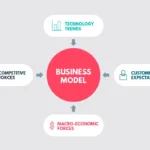THE ANATOMY OF DIGITAL TRANSFORMATION
Part 2 of 3: Business & Digital Transformation (Read Part 1 and Part 3)
When business leaders think of digital transformation, they often misunderstand the real need and true impetus behind it.
The word ‘digital’ in digital transformation could get confusing and misleading, often sending business leaders off on a tangent. Digital transformation is not just transforming your digital channels or underlying systems and technical platforms.
The real reason why we talk about digital transformation, and why organizations need to focus on this initiative now, is because ‘digital’ is either the main ingredient, or catalyst that’s forcing organizations to re-assess and change their business models. It’s the new, emerging technology around us that’s shaping consumer behaviors and expectations as well as their interactions and engagement with the brand. This radical change, evolution, and adoption of the technology and its impact on all of us is the real reason why transforming your organization digitally is so essential. In The Paradigm Shift of Business Transformation, I emphasize transforming the business; not just the technology.

Many companies, however, are unable to successfully navigate this transformation as their leaders struggle to ask relevant business questions. Forbes recently reported that 55% of companies are only in the nascent stages of transformation and struggle to ask the business questions necessary to drive the change. The focus is less on business outcomes and more on re-platforming the technology. This approach is myopic and one-dimensional. Often organizations think that merely upgrading or replacing their underlying digital platforms and infrastructure is enough. However, it’s just a start; and in many cases, it might be the wrong start.
Companies who take great pride in their technology excellence and focus heavily on R&D, often lead with a ‘technology overhaul’ during their transformation journey, and are in danger of losing focus on their customers and risking the business. Polaroid is one example. Once the pioneer and innovator in the photography business, Polaroid failed to transform itself when face with a changing environment. Polaroid’s leadership continued to invest heavily in research and technology without adequately considering how customers would respond. Not surprisingly, sales stagnated. The rest is history.
In this digital age, customers have myriad choices for how and when they engage with a brand. Democratization of technology has enabled consumers and businesses to have easy and rapid access to new products and solutions. Speaking in economic terms, seemingly inelastic choices quickly become elastic. Apple is a prime example: they are not the only option in town for amazing smartphones. Android has created an alternate marketplace giving numerous compelling choices to consumers. Google adopted a very different business model than Apple and succeeded wildly. Google’s approach to open-source the Android platform gave rise to many existing and new mobile companies to enter the space, and challenge Apple’s monopoly.
Another notable example is in the TV and cable industry. Comcast, DISH Network, and others have dominated this space, and up until recently, there was little to no choice for consumers to select specific packages for their TV and phone bundles. However, with the advent of Hulu, Netflix, Amazon Prime and others, including premium cable networks such as HBO launching HBO Now, consumers now have more choices and can curate various content subscriptions to their personal needs. Access to the new technologies has enabled these new digital entrants to go head-to-head with industry heavyweights and challenge the established business practices along the way.
Competing with digital-first brands that don’t carry the baggage of legacy systems is a completely different ballgame. To not only survive but surpass the competition, marketers need to bring a laser focus attention to the digital experiences across all customer touchpoints. GE and IBM — companies that are 100+ years old and are huge enterprises — have successfully transformed themselves and stayed relevant in the 21st century.
KEEP CUSTOMERS TOP OF MIND
As mentioned in “The Paradigm Shift of Business Transformation,” besides the technological trends and forces that bring new competitors to the market, another force that is equally, if not more, important is the customer and their constantly changing and evolving expectations.

By assessing the as-is state of the business, including existing customer segments, online and offline channels, key resources and activities, the partner network, and competitors, marketing executives must seek an open-ended exploration of user behaviors. It’s useful in delineating the emotional context in which users make decisions, their key pain points, and enablers. Understanding the key research themes, audience profiles, and white space in the industry, businesses need to prioritize markets and product offerings. A true understanding of a user occurs over a period of time, which allows for a deeper understanding of his or her characteristics, actions and intentions, and builds a rich user profile based on various data attributes.
Having a customer-centric mindset forces businesses to think strategically to create useful and engaging experiences and to challenge their own status quo. Designing or building digital platforms to support omni-channel experiences will be the key undertaking for technology teams. Start small. Test and learn. Apply the principle of crawl-walk-run. But, do it with intention, commitment, and defined milestones to avoid getting stuck with old processes. Continuous optimization of these platforms over a period of time, enabling rapid and iterative launches of various solutions and digital artifacts, will be critical to the success of the business.
A CONNECTED ENTERPRISE & DIGITAL ECOSYSTEM
Creating unified, seamless, and delightful customer experiences must be the top priority for organizations that want to transform digitally. But creating such immersive experiences is only winning half the battle. The full potential is unleashed when digital transformation initiatives influence and improve all the business functions — R&D to product development, engineering to sales, customer service to the call center, and all the brand engagement and marketing touchpoints in between.

The key to achieving this 360˚ organizational impact and improvement is the investment in the digital ecosystem. The investments that are top focal points for digital transformation are cloud, mobile, and analytics. To achieve the best ROI on marketing dollars, investing in the marketing technology stack and leveraging it to form a connected digital ecosystem is equally important. When assembling a marketing technology stack, it’s important to know which technologies are foundational, and should be put in place first. Both B2C and B2B marketers should evaluate and consider if a content management system (CMS) is an appropriate investment for the organization, as well as for building engaging customer experiences. Further, marketing automation solutions need to be explored to help bring the value and ROI to numerous marketing efforts such as email campaigns, lead management, social marketing, and account-based marketing.
Companies now have access to multiple data sources from various customer touch-points. A recent report from Forbes Insights shared some efforts into how Intel achieved over a billion dollars in incremental revenue and productivity gains in the last two years, thanks to its investments in the company’s data layer. Data and analytics allowed the company to see transactions from the customer all the way back to product engineering, which helped forecast the right product mix and demand. Intel also created a predictive model that fundamentally transformed how it engages in its reseller channel, which also generated a couple of hundred million dollars in revenue.
When approaching digital transformation, many companies turn to traditional KPIs and metrics to help validate the success of new investments. Although this helps frame them within existing business paradigms, strategists must rethink performance metrics to chart future development in new channels, experiences, content, and devices. Defining what success looks like, measuring results, and optimizing them on a continuous basis is easier said than done.
THE FUTURE OF TECHNOLOGY AND TRANSFORMATION
With recent advances in machine learning and natural language processing, we are also seeing companies experimenting with AI and various kinds of task automation. As the conversational interfaces mature, we will see more human-like interactions with the technology. Technology needs to be invisible. Frictionless. AI and cognitive computing is the new frontier for all companies to explore and invest into.
Transformation is a multi-dimensional journey that drives business change, puts the customer first, and digital at the core. Digital transformation is as much about the transformation of business models, cultures, and operations of organizations, as it is about technology.
Note: Originally, this article was published in Spring of 2017 on R2i website.



